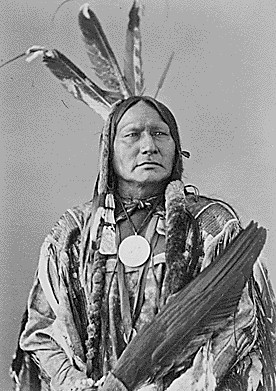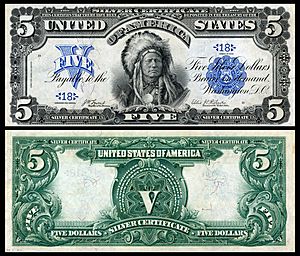Running Antelope facts for kids
Quick facts for kids
Running Antelope
|
|
|---|---|
| Tȟatȟóka Íŋyaŋke | |

Running Antelope
|
|
| Hunkpapa leader | |
| Personal details | |
| Born | 1821 Grand River, South Dakota |
| Died | 1896 (aged 74–75) |
| Resting place | Long Hill Cemetery, Little Eagle South Dakota |
Running Antelope, also known as Tȟatȟóka Íŋyaŋke, was a respected leader of the Hunkpapa Sioux people. He was born in 1821 and lived until 1896. In 1851, he became a head chief of the Hunkpapa.
Running Antelope was known for his courage in battles and his amazing speaking and negotiation skills. He was one of the main Hunkpapa chiefs who advised Sitting Bull during the Plains Indian Wars. Running Antelope believed it was best for his people to find ways to get along with the white settlers. This belief eventually led him to disagree with Sitting Bull.
He is the only Native American ever shown on U.S. paper money. The picture on the 1899 $5 Silver Certificate caused some problems. It showed Running Antelope wearing a Pawnee headdress instead of his own Sioux one. His Sioux headdress was too tall for the picture.
Contents
Growing Up: Running Antelope's Early Life
Running Antelope was born in 1821 near the Grand River in what is now South Dakota. At that time, very few white people lived in the area. This meant he grew up following the old traditions of his people.
He learned important skills like riding horses and hunting. He also joined groups that went on horse-stealing trips and war parties. By the time he became an adult, things had changed a lot. More white settlers were arriving, and Native Americans had to adapt.
Many Sioux groups became strong warriors. The Hunkpapa, a smaller group of the Tetons, became one of the most powerful. However, Running Antelope was one of the first Hunkpapa leaders to choose peace instead of war. He wanted to be a friend to the white settlers. In his younger years, Running Antelope was good friends with Sitting Bull, who was eleven years younger than him. Running Antelope was a very important leader among the Lakota people.
Becoming a Hunkpapa Leader
In 1851, Running Antelope was chosen as one of four "shirt wearers" for the Hunkpapa people. A "shirt wearer" was a special leader who helped connect the tribal council with the headmen and warriors. These leaders helped carry out the tribe's plans and decisions. Running Antelope was a brave fighter and a skilled negotiator.
He attended important meetings with the Sioux at places like Fort Laramie and Fort Rice in 1868. Running Antelope signed the Treaty of 1868 at Fort Rice. Many people said that Running Antelope was the best speaker in the entire Sioux Nation. He also went to treaty meetings at Fort Peck.
Later, with the help of James McLaughlin, Running Antelope became a main leader for the Hunkpapa people living on the reservation at the Grand River Agency. In 1868, he was officially registered at the Grand River Agency. This area later became part of the Standing Rock Indian Reservation in North and South Dakota.
After land was divided up, Running Antelope created a settlement of about sixty families in the Grand River valley. He even opened a store there. In his later years, he felt sad about signing the 1868 Treaty. He missed the time when the Lakota were free and became closer to Sitting Bull again. In late 1880, Sitting Bull's followers started returning from Canada. In the spring of 1881, Running Antelope became an army scout. He went to Fort Buford to help escort another chief, Gall, and his followers to Standing Rock.
The Last Great Buffalo Hunt
In June 1882, Running Antelope was chosen to lead the last big buffalo hunt for the Sioux. A huge herd of buffalo was spotted about one hundred miles west of Fort Yates. On June 10, about 2,000 men, women, and children left the fort to hunt.
The next morning, they saw the herd, which had about 50,000 buffalo! The hunt began, and about 2,000 buffalo were killed on the first day. The camp then moved closer to where the hunting happened, and everyone started butchering the meat. The next day, another 3,000 buffalo were killed. The camp then settled near a creek to dry the meat into jerky and make pemmican. As always, when there was plenty of meat, the work in the camp felt lighter because everyone could feast.
Running Antelope's Later Years
In 1899, Running Antelope's picture was put on the Five-Dollar Silver Certificate. He passed away sometime between June 30, 1896, and June 30, 1897. There have been many ideas to replace Andrew Jackson on the $20 bill with Running Antelope. He is buried at the Long Hill Cemetery, which is east of Little Eagle, South Dakota.
In 1885, a list from the Standing Rock reservation showed that Running Antelope was responsible for ten family groups, totaling 42 people. Some of these people included Wahacanka Sapa (Black Shield), Mato Luta (Red Bear), Edwin Phelps Aknan Iyanke (Runs on It), Mato Hotanka (Loud Voice Bear), Rlaya Wakua (Chase Rattling), Winkta Yuza (Married to Hermaphrodite), Cante Witko (Fool Heart), Pte San Waste Win (Pretty Grey Cow), and Tatanka He Ksa (Broken Horn Bull).


